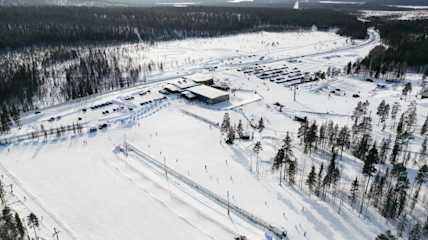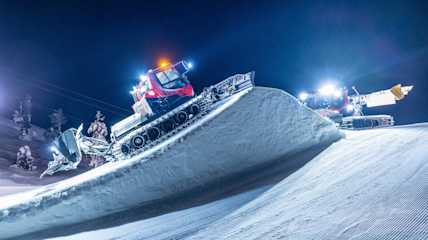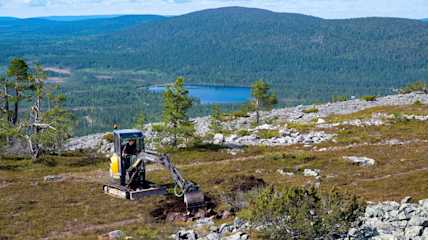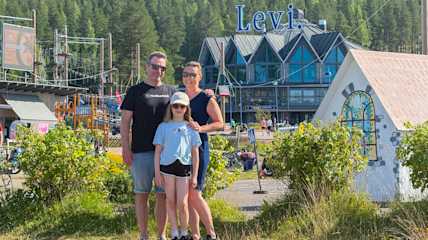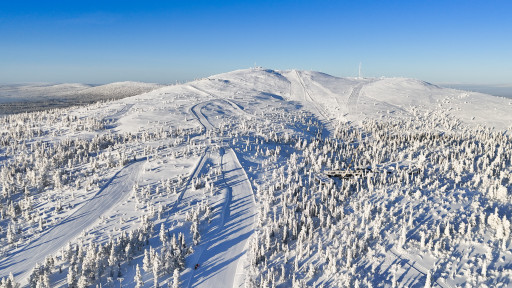
Calculation and reduction measures of the carbon footprint of Levi Ski Resort
We interviewed Tuukka Sutinen, the sustainability manager of Levi Ski Resort, who informed us about the latest carbon footprint calculation of Levi Ski Resort Group as well as the implemented and planned measures for reducing the carbon footprint.
In the latest carbon footprint calculation, a calculation method based on the GHG Protocol was used, and the calculation examined one financial year (October 2022 - September 2023). Compared to previous calculations, the scope of the calculation was broader, including not only emissions directly and indirectly generated from own operations (scope 1 and 2 emissions) but also other emissions from the value chain (scope 3 emissions).
The carbon footprint calculation and reporting were conducted by Nordic Impact Ltd, ensuring accurate and comprehensive assessment and reporting of the carbon footprint.
- The first calculation was conducted in 2020 in collaboration with Metsähallitus in the Tobe Low Carbon project, aimed at seeking the most cost-effective measures to reduce the carbon footprint of Pallas-Yllästunturi National Park and the businesses operating in its immediate vicinity. Now that these actions have been taken, it was timely to refine the calculation to cover the carbon footprint of the group and update the company's climate plan, Levi Ski Resorts sustainability manager Tuukka Sutinen explains.
The Levi Ski Resort group comprises Levi's slope services and slope restaurants. Levi Ski Resort's business includes ski pass sales, ski school, rental operations, and textile sales. Levi Restaurants is a subsidiary of Oy Levi Ski Resort Ltd, responsible for the slope restaurant operations of the Levi Ski Resort group.
RESULTS OF THE CALCULATION
For the financial year 2022-2023, the total carbon footprint of the Levi Ski Resort group was 4602 tonnes of CO2e. The most significant emission source was Scope 3 purchased products and services, accounting for 40% of the total carbon footprint. The second largest was Scope 1 fuel usage, accounting for 30%. The share of other emission categories was a total of 24%, with over half of them resulting from annual depreciation of production and capital goods. The calculation takes into account emissions upstream in the value chain as well as investments through annual depreciations.
DEVELOPMENT OF THE CARBON FOOTPRINT
Levi Group's Scope 1 and 2 emissions decreased from 2019 to 2023 by approximately 1290 tonnes of CO2e, which corresponds to almost a 50% overall reduction. The largest reduction was achieved by transitioning to using entirely emission-free purchased electricity.
- Electricity accounts for over 60% of the ski resort's energy consumption. In addition, fuels play a significant role in the carbon footprint. We have transitioned to using renewable fuel in slope, route, and trail machines, the impact of which will be reflected in the calculation for the financial year 2023-2024. However, the reduction in carbon footprint from the fuels used by the machines is estimated to be 70-90%, which means a significant reduction in the company's carbon footprint, Tuukka explains.
EMISSION REDUCTION MEASURES
Already implemented measures include considerations of energy sources, introduction of electric vehicles, modernization of slope equipment, and adoption of LED lighting. Future plans include transitioning to electric equipment, implementing solar panels, developing travel practices related to commuting, and renovating properties.
- Electricity and fuels are the big things for us in terms of energy. In addition to transitioning to renewable fuel, in terms of fuels, we are transitioning to sustainable heating methods in all our properties. Our Front Slopes maintenance facility is still heated with oil. Gondola Race Centre was switched to geothermal energy during the summer of 2024, which will also have a significant impact on the carbon footprint. The annual consumption of heating oil for the Gondola Race Centre is 89,000 litres, which will be eliminated with the renovation. This accounts for about 8% of the ski resort's energy consumption, making it not only a significant environmental but also an energy efficiency and cost-effectiveness improvement, says Tuukka.
The remaining Front Slopes maintenance facility will be decommissioned as the services on Front Slope are renewed. Sustainable heating solutions are always implemented in new projects.
CONTINUATION OF CLIMATE WORK
From an environmental perspective, it is essential to take actions that directly reduce and prevent environmental impacts. After this, it is possible to take other types of measures, such as offsetting emissions. Currently, the ski resort is considering various ways to address new challenges.
- Our agenda is to influence through genuine actions. For example, in climate matters, these investments in new sustainable solutions are these genuine actions. We are in a grateful position that, through long-term work, we have already done a lot in terms of our operations. From a climate perspective, things that previously seemed insignificant begin to play a more significant role. Currently, most of our emissions come from sources other than our own operations, such as purchases. Therefore, we are examining the sustainability of our suppliers to ensure that our actions from a value chain perspective are on a sustainable basis, Tuukka says.
Levi Ski Resort has committed to the Glasgow Declaration program of the global tourism industry. The goal is to reduce emissions by 50% by 2030 and strive for net-zero emissions as soon as possible but no later than 2050. Levi Ski Resort also aims to support Finland's national climate goals.
